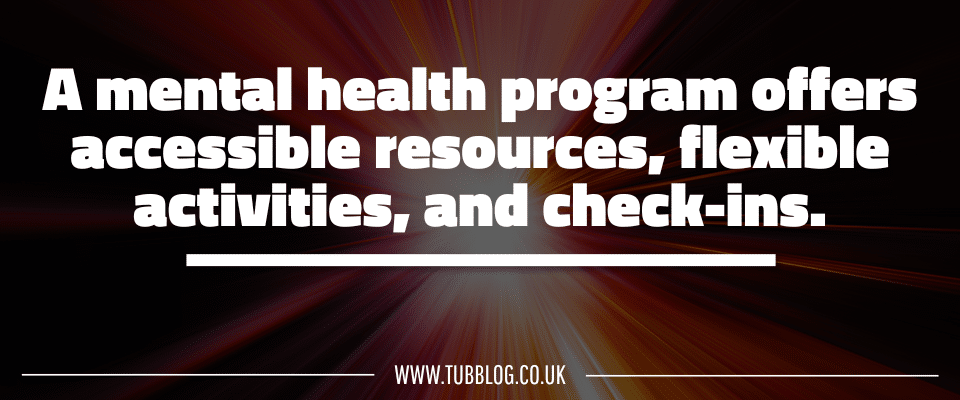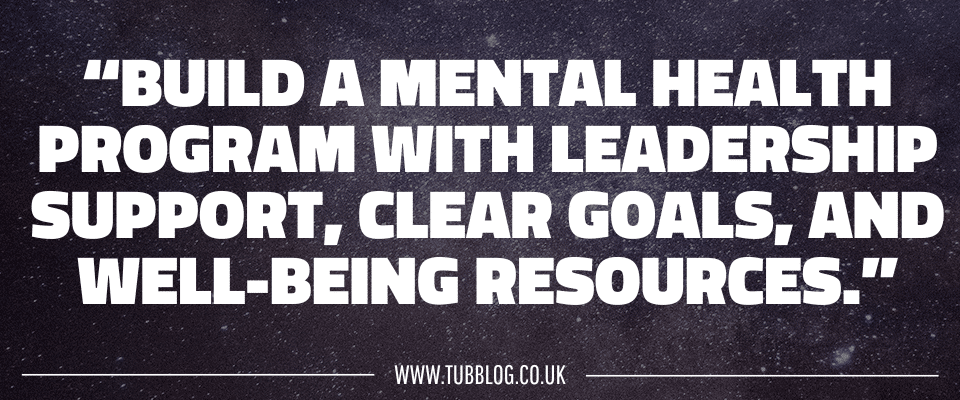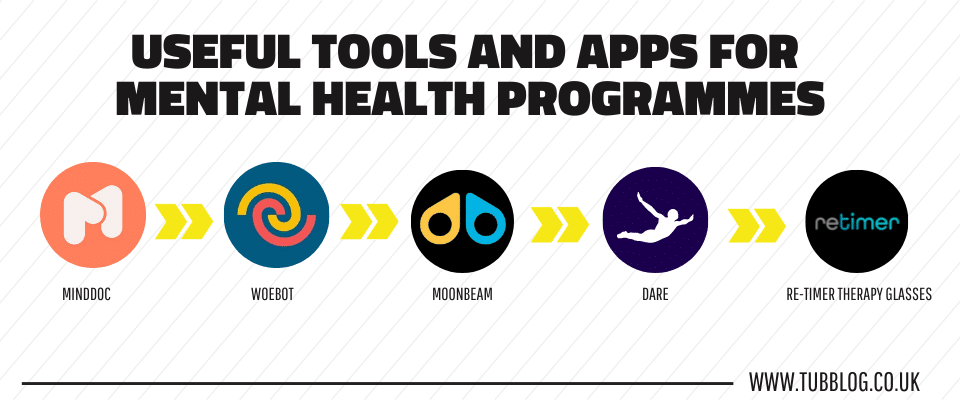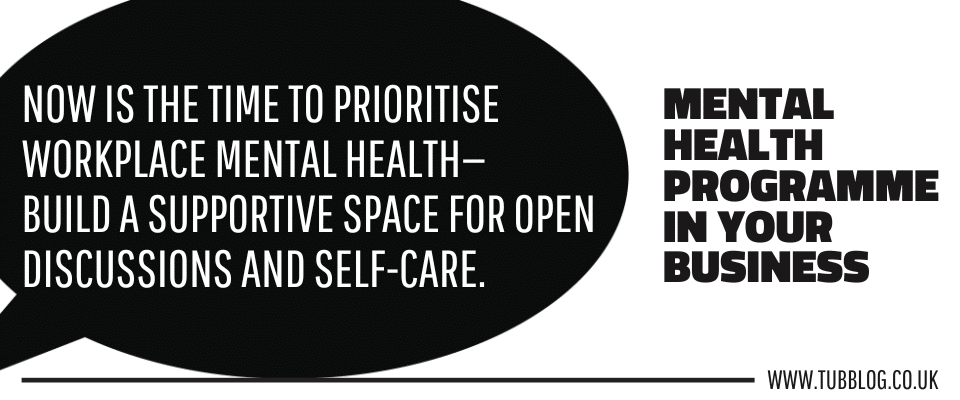Mental health is an important topic for us here at Tubblog. We all struggle with stress and mental health occasionally – and at work, it’s never been more important to show your team that you care about their wellbeing.
And, that’s not just because poor mental health could have an effect on project outcomes! A mentally fortified, confident, and happy team is one that’s always keen to get into the next challenge. You’re managing a team of ambitious people who seize training and career opportunities with gusto and self-poise.
However, many people are struggling to find this confidence, and to balance their stress and anxiety levels in the workplace. In fact, various pieces of research suggests that most people are increasingly finding work more stressful and exhausting. And they are struggling with pressure, anxiety, and depression.
As an MSP and an employer, you have a duty of care to ensure your people are supported no matter what they do for you. That can include making sure they have accessible resources to help manage mental health, relieve stress. Or a simple thing like time off for headspace.
How to set up a Programme
However, setting up a mental health programme or support scheme isn’t an exact science, and it can be tough. After all, we all have different wants and needs. For some, it might simply be enough just to cultivate a culture that welcomes open discussion about mental health problems.
So, in this guide, I’ll take you through what an MSP mental health programme might entail, why it’s worth setting one up, and how you can get started. I’ll also recommend a few apps and services that the Tubblog team has already got behind. These are tools we’ve already used ourselves behind the scenes.
Ultimately, prioritising your mental health has never been more important. Because you and your team should always feel comfortable and empowered to speak up and openly about things that worry or overwhelm you.
What is a Mental Health Programme?
A mental health programme is a plan or initiative set up by a business to prioritise the mental wellbeing of its staff. It could:
- Help people open up about what’s bothering them
- Offer direct programs and counselling
- Provide stipends to help people find help outside of work
Regardless, programmes don’t have to follow any fixed shape or pattern. It could be a floating, holistic set of activities that people can pick and choose from as they see fit. For example, people in your team might choose to use journal apps, or take personal time to meditate.
Or, you might even introduce mental health aspects into personal development plans to help people check in with themselves while developing professional skills.
A Good Mental Health Programme
Regardless of the shape it might take, a mental health programme should be accessible, flexible, and exist to help make life easier for those who work with you. You should never set up a programme purely to hit targets or tick boxes – don’t be disingenuous.
If you have a few ideas about what you might want to include in your programme, there are some handy templates out there that you can pick apart and build upon. As mentioned, there’s no correct plan of action – talk with your employees and find out what they need.
To start, take a look at Mind’s collection of Wellness Action Plans. The mental health charity has put together three digital packs that workplaces and remote or hybrid teams can use to help support each other in the workplace.
There are a few forms to fill in, but it’s a fantastic springboard. Mind is a superb charity that works hard to support people and organisations across the UK impacted by mental health struggles. And this is just one example of their brilliant resources.
Beyond this, take a closer look at some of our guides already published at Tubblog. For instance, Richard previously posted a guide to some exceptional mental health resources MSP owners can use to support themselves and those they employ.
Why Set up a Mental Health Programme?
It’s never been more important to speak up about mental health. Workplaces that remain tight-lipped and cross-armed to discussions risk developing a culture bogged down by resentment, stress, and unfounded negativity.
Many people struggle with mental health because of work, too. Research suggests that at least 875,000 of us have suffered with work-related anxiety, depression, or stress. That’s just over 2% of the adult working population of the UK. It might not sound like much, but keep in mind these statistics are based on people who are willing to speak up.
Many people might be suffering in silence. People who feel their mental health is suffering at or because of work stand to take more sick days, and others might be at higher risk of leaving companies altogether.
Companies that fail to address the mental wellbeing of their workforces could, therefore, see absenteeism and turnover skyrocket. Moreover, they’re throwing away genuine talent which could burst through if people felt that little bit more confident and comfortable in themselves.
The Benefits of Supporting Mental Wellbeing at Work
What’s more, a company that invests in mental health is immediately more attractive to outsiders, such as talented applicants who have been let down elsewhere. However, you must ensure that your programmes are genuine and come from a place of support and kindness.
Having open conversations with your people – even if it just means encouraging them to be more honest with themselves about how they’re feeling – will go a long way. We’re well beyond the days of squashing down mental struggles being a recommended course of action.
More than 75% of managers believe there’s a lack of education regarding mental health in the workplace. What’s more, research also suggests that the majority of workers struggling with mental health either feel embarrassed, are worried about ramifications for their careers, or don’t believe their employers are capable enough to help.
These shocking statistics paint a pretty stark picture – that businesses need to not only do more to acknowledge employees’ mental health, but that they also need to create a safe, open culture free from judgment and repercussions.
A great way to kickstart this, of course, is to build a mental health programme!
Steps to Setting up Your Own Programme
Again, you might use Mind’s brilliant templates to help you get started. But remember that there are no right or wrong answers to setting up your own mental health programme. You don’t even have to formalise any kind of structure unless you feel it might help others.
That said, formal action plans (or even those drawn up roughly) are great for accountability. They’ll also help you make sure that your workplace supports people with mental disabilities as outlined within UK employment law.
So, here are a few steps you could take to draft your own mental health programme to support your managers and employees moving forward.
Get Buy-in From Business Owners
Di you run your business with partners, or have a number of stakeholders or shareholders? Then ensure there’s buy-in from any decision-makers in the firm.
Very few will turn down the chance to support mental health in the workplace. But going ahead with a new initiative or programme without consulting the key players isn’t a great plan!
Lay out a plan with objectives and make sure you get signed or recorded permission to move ahead – and then you’re clear to plan further.
Set Aside a Budget and Plan for Roles and Responsibilities
If you intend to supply your staff with equipment, apps, or stipends so they can access their own mental health resources, you’re going to need a clear budget. This is a key conversation t0 have with the decision-makers.
Make sure to budget for any outside support or training you bring on board, too. Look carefully at your financial projections and think carefully about what you can feasibly afford at this moment in time.
There are also free ways, of course, for you to manage elements of such a programme.
For example, you could simply change elements of your personal development plans, build meetings around mental health discussions, and encourage people to be more open with you.
It’s also a good idea, however, to get support on side from people willing to help launch your programme. This might be current staff or managers, or partners in your business.
Are there elements to your scheme that you could delegate to interested people? What skills and talents could you make use of from within the company to get mental health projects off the ground?
Consider an open call for help from your team. The incentive? A fully operational and supportive mental health programme.
Invest in Self-Help Resources
There’s no reason why you have to manage or oversee all of the resources and tools that staff can use within your mental health programme.
For example, use some of your programme budget on setting up apps and services they might use in their spare time.
Some of the best apps – which I’ll take a look at with you below – work on a solo basis. So, team members can simply log in and record how they’re feeling. Or even discuss what’s going on in their lives with a chatbot.
This line of planning might be particularly useful if you want to support those who don’t feel confident enough to speak up.
This way you introduce helpful resources to them, and they might eventually speak with you about the help they need.
Look at the Bigger Mental Health Picture
Mental health doesn’t start and end with feeling down or stressed occasionally. There are lots of different triggers and factors that can exacerbate long-term feelings of depression and anxiety.
Therefore, take the time to dive deep into the different factors that could be causing mental health struggles for your team. Consider sending an anonymous survey throughout the company to ask about what areas of their lives produce the most stress or worry – with no pressure to complete.
For example, with the results, you could find some people are worried about money or career prospects. You could, therefore, build some areas of your programme around upskilling – which could increase salaries and senses of wellbeing.
Otherwise, some people might struggle with feelings of worthlessness or body dysmorphia. In which case, you could bring on board counsellors or workplace therapists. Or, you could even set up gym memberships or nutritionist sessions for people who want to feel better about their bodies.
Regardless, always make sure to tread carefully, and don’t assume that you know all the answers to the problems people are going through.
Train Managers on Mental Health Red Flags to Look out for
If you’re the owner of your MSP, it’s reasonable to expect that you might not always have complete oversight of your programme’s initiatives at all times.
Therefore, take time to make sure the managers and supervisors who will be supporting your staff have the knowledge and tools to prioritise their mental health.
This, again, doesn’t have to be an exact science. Simply keeping everyone on the same page and getting the workplace behind the concept of an open, supportive mental health culture will likely be enough for many managers.
That said, it’s a good idea for everyone to learn more about what mental health problems might look like, and why it’s important to discuss these matters.
You could create regular workshops with your team where people might feel comfortable exploring their feelings. Don’t make it compulsory – rather, make it clear what your sessions will involve, and what people are free to talk about when they attend.
Set up Charity Initiatives
One of the best ways to improve mental health is to get better connected with others and to do good. Of course, there are many different struggles that people will be going through.
But a great way to raise company morale and to inspire the workforce might be to set up charity initiatives for causes that your employees care about.
Invest in Counselling and Space for People to Unwind and Process
We all need time and space to unwind and process complex thoughts and emotions. Therefore, consider making a special space at your workplace purely for people to retire to when they need to take a few moments away from projects.
You could also invest in in-house counselling or therapy. This could be very useful for people who don’t have access to therapists outside of work, or who are keen to learn more about therapy but are unsure about the best steps to take.
There are no right or wrong ways to build a mental health programme at work. What’s most important is you listen to your team and colleagues. And, show that you genuinely care about what they’re going through.
For more insight and advice, take a look at our guide on how to promote positive wellbeing at work.
Useful Tools and Apps for Mental Health Programmes
To close, I thought I’d take a quick look at some fantastic mental health apps and tools that have helped many of us here at Tubblog.
You could invest in any of the following to support your mental health programme. Whether it’s through guided use or to encourage people to explore on their own.
We’ve broken down each of these resources further in separate guides on the blog, too. So make sure to check out the more detailed reviews if you’re interested!
MindDoc
MindDoc is a superb mental health ‘companion’ – it’s a free app that asks you daily questions to help you check in with your wellbeing and mood patterns.
For people who feel they are struggling to control mood patterns and manage their thought processes, it’s a fantastic way to help lay out things in a neat, analytical perspective.
It could be an app you roll out across your workforce – and I highly recommend the paid version for extra features.
Check out what Richard has to say about MindDoc here.
WoeBot
Pardoning the clever pun, WoeBot is an exceptional piece of AI that lets users explore the root causes of anxiety and depression through cognitive behaviour therapy techniques.
Specifically, it’s a great platform for people who might not feel comfortable talking with others about their problems to chat without fear of judgement.
This chatbot listens to what you have to say and can be extremely helpful in overturning moments where you might feel particularly low or helpless.
I think it’s a great little app that you could roll out as part of a mental health programme. And you can dive into more about its features with our complete WoeBot review.
Moonbeam
Moonbeam is a piece of wearable tech that I personally absolutely love. It’s a wristband with two simple buttons – one with a yellow button that you press when you feel positive, and a blue button that you press when you’re feeling low.
The wristband then connects to an app on your phone that helps you to monitor how you’re feeling across the day, to spot patterns, and to start understanding certain triggers.
It also doubles as a great little pedometer and a sleep tracker, too. Because regular exercise and a healthy sleep schedule are both important when trying to manage your mental health.
The Moonbeam One wristband is available for a one-off cost of £49.99 at the time of writing, with a free app. Read our Moonbeam review for a more detailed dive into what to expect.
DARE
The DARE app is a free resource that people struggling with anxiety can use to get swift help at a moment’s notice. And offers audio training and SOS programs that can help you manage attacks as and when they arise.
It’s a great resource to use when you feel overwhelmed or overcome by negative emotions and thoughts. Specifically, it plays a ten-minute piece of audio that will help you recentre yourself and regain perspective.
It’s free to download but offers a subscription service, too. This unlocks more features and tools that you and your team can use for months to come. I think it’s a great resource you can budget for in your plan, and if you’d like to know more, start with our full DARE app review.
Re-Timer Therapy Glasses
Let’s close with another piece of intriguing wearable tech. Specifically, Re-Timer therapy glasses – which work with the principle of light therapy.
Light therapy can help ease some of the symptoms you might experience during the change of seasons. And it can even support you on the way to building healthier sleep patterns.
Each pair of glasses costs around £179 at the time of writing. The glasses emit gentle light and energy around your face to help rebalance your eyes – and your mind, too. They can even help to boost your energy levels!
Whether you suffer from seasonal affective disorder (SAD) or jet-lag, Re-Timer glasses could be a sound investment – and even for the whole team in bulk. Learn more with our Re-Timer Light Therapy Glasses review.
There’s no Better Time to Prioritise Mental Health in the Workplace
Creating your own mental health programme for the workplace can be tricky . But, provided your intentions are clear and honest, and you have support from likeminded people in your team, you’ll be on track to creating a more supportive atmosphere for discussions and self-management.
We all struggle with mental health sometimes – and please don’t suffer in silence. Take a look at the advice and resources I’ve suggested above. And, as always, if you have any questions or advice of your own, we’d love to hear from you!



















Comments